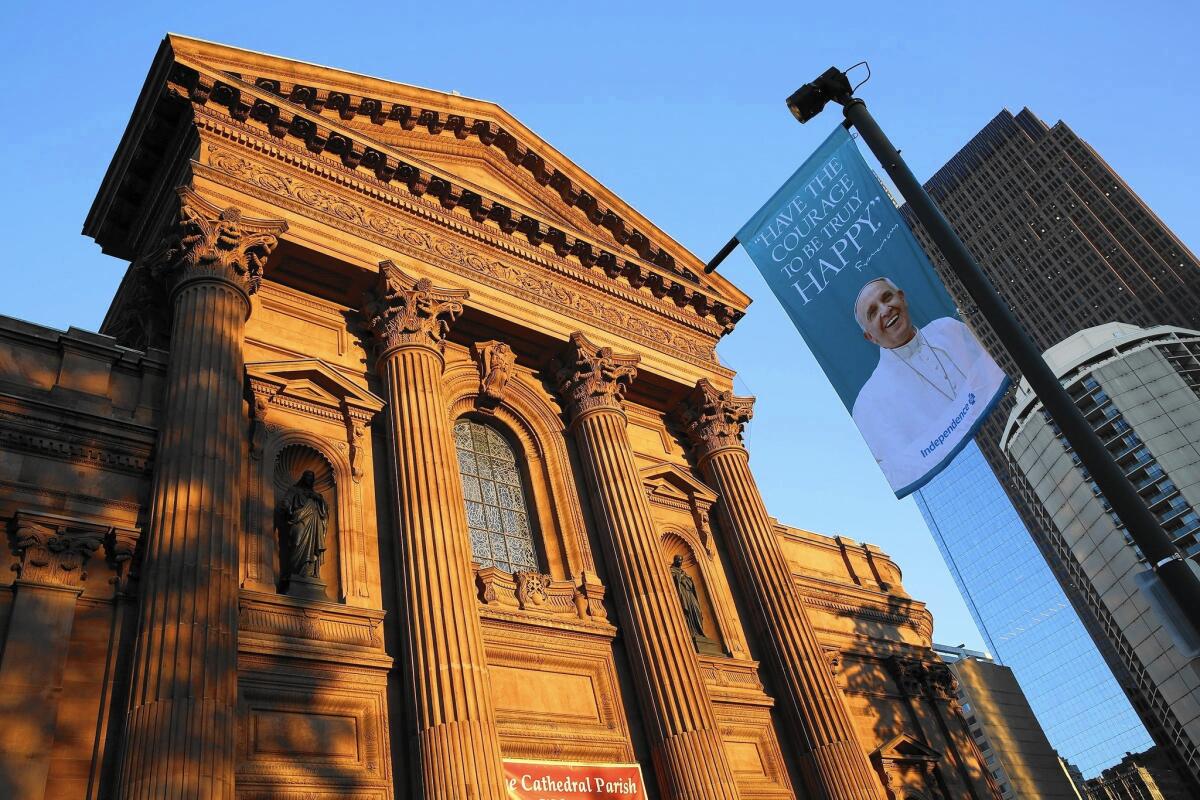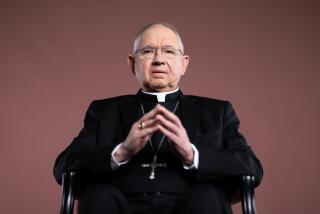U.S. Catholic Church at a crossroads: Pope Francis appeals to competing currents

The Cathedral Basilica of Saints Peter and Paul in Philadelphia anticipates Pope Francis’ visit.
- Share via
Reporting from PHILADELPHIA — The church in a formerly prosperous neighborhood of doctors and lawyers cannot afford to replace a metal cross atop the steeple that was struck by lightning years ago. Inside, a vast net in the majestic sanctuary protects parishioners from falling plaster.
Yet the new community garden at Our Lady of Hope sprouted peppers, tomatoes, cabbage and bitter melon this summer for the north Philadelphia neighborhood that surrounds it, and the adjoining newly independent high school that aspires to send low-income students to college will graduate its first class.
This parish, not far from where Pope Francis will celebrate the largest Mass during his first trip to the United States this week, is like the American Catholic Church itself, battered but still working and, in spurts, redefining itself.
“There’s a lot of hope here,” said Father Efren Esmilla, pointing to the students as he stood in the garden.
When Francis says Mass for hundreds of thousands of Catholics from a pulpit outside the Philadelphia Museum of Art, he will look out at parishioners and clergy who are debating their primary mission, struggling to reconcile doctrine with modern life, and working to integrate a burgeoning immigrant population that is sustaining the Roman Catholic Church in the United States.
It is a church that has closed schools and sanctuaries with increasing frequency as it attempts to emerge from a child sex abuse scandal that depleted funds and disillusioned or drove away many of its members, in Philadelphia and across the country.
In Francis, American Catholics have a popular leader who offers a consoling message of mercy and compassion. But he also challenges the faithful to follow unwavering doctrine and adds a dimension that may be particularly uncomfortable for his audience here: a critique of capitalism that is an article of faith in America’s secular identity.
Which prompts a question: What will be the lasting legacy of America’s embrace of Francis — on the church, its parishioners and maybe even the pope?
::
Sister Gertrude Borres cracked self-deprecating jokes over the squeaky wheels of her 7:30 a.m. subway to Mass, before passing a woman with hot pink hair, a homeless man sprawled on a platform, and a security guard sleeping on a hard chair.
She wore a large metal cross and a red pin with the pope’s picture on her white shirt, but no habit.
“This is where you get the Main Street of people, and that’s what I like,” said Borres, who is director of evangelization for Our Lady of Hope. “It brings me to the vortex of the issues that face the church in the United States.”
This mixing with society is very much in keeping with Francis’ call for a church that’s like a “field hospital,” not far removed from its flock. But Borres, 66, worries that younger people are not filling its pews or seeing its good work as she does.
“The church, for many people, is irrelevant,” said Borres, who spent most of her life in her native Philippines. “The secular approach to society, here in the United States, is so strong.”
All but one of the 11 people who joined Borres at the weekday Mass were older, a common sight across the country as the church struggles to win over millennials. But the group was diverse, whites, Asians and blacks, who sang “Lord Have Mercy” and celebrated the life of St. Peter Claver — the patron saint of slaves — in an intimate chapel set apart from the cavernous sanctuary.
Our Lady of Hope is the result of a 1993 merger that combined three parishes that were losing members. The 180-foot-high stone structure towers above a neighborhood that includes entire blocks of decaying row houses, interspersed with better maintained middle-class sections.
It is majority African American, with growing immigrant membership. It holds three Sunday morning Masses: African American gospel at 8:30, Spanish language at 10:30, and one for Philippine worshipers at 12:30.
Immigrants are the main force preventing a sharp decline in church membership nationwide. Estimates put the U.S. Catholic population at about 72 million, with some projections slightly higher, others well lower.
A new Pew Research Center study found that 9% of Americans called themselves “ex-Catholics.” Another 9% identified as “cultural Catholics” — those who consider themselves Catholic in some way even if they are now Protestant or have left Christianity.
“I have friends who say it’s just boring,” said Alicia Reyes, a 19-year-old college student who works part time at Our Lady of Hope. Among them are gay friends who feel unwelcome in a church that regards homosexual acts as sinful.
Eloise Gonzales, who runs a program at Our Lady that educates lapsed Catholics, said many people left the church because of the child sex abuse scandal. “They’re mad at what the priests did,” Gonzales said. “If they’re really Catholics, they come back.”
Philadelphia Archbishop Charles J. Chaput told reporters last month that he had been reluctant to host the 2015 World Meeting of Families, at which the pope will appear, when he was approached by the Vatican three years ago.
When he finally submitted an application, he included a letter explaining problems the abuse scandal had unleashed in the Archdiocese of Philadelphia: a grand jury investigation, more than two dozen priests put on administrative leave, closed schools and parishes, an operating deficit that reached $17 million.
“All of this happened in a diocese that saw itself, and I think rightly so, as one of the flagships and icons of the Catholic Church in the United States,” Chaput said.
Despite these problems, he said, the church in Philadelphia plays a fundamental role in the American Catholic experience — it is where Catholic parish schools began. In the 19th century, Philadelphia was one of the main entry ports for Irish and other immigrants. And immigrant communities continue to grow in his city.
::
Father Esmilla, the first Filipino ordained in Philadelphia, speaks English, Spanish and Tagalog, the main Philippine language.
Since he began leading Our Lady of Hope nine years ago, he’s refreshed his Spanish skills so he can celebrate Mass with his Latino parishioners. To show solidarity with African Americans, he has “learned to eat what they eat and worship the way they worship,” even altering how he walks to the beat of the gospel music during Mass.
But there are frictions, large and small.
Some African Americans stopped attending years ago when the English-language Mass was moved from 10:30 to 8:30, a less convenient time for many. Others expressed disappointment when a nearby church that was part of the 1993 merger, Our Lady of Holy Souls, closed. It had been used as a worship site until two years ago.
Esmilla is trying to unite those who have stayed in his increasingly diverse church by holding more events that fuse all three cultures, including trilingual services during Holy Week leading up to Easter and other large celebrations. He urges congregants to share “the great gift of their identity.”
Esmilla, 53, agrees that many young people feel the church is not meeting their needs. He said he believes Francis will bring former Catholics back to the faith.
“With Pope Francis, his mentality is always for the poor and always with mercy and compassion,” Esmilla said. “The Catholic teachings are very strict, but being a pastoral pope, [he] is able to reach the heart of the people.”
Francis, while not altering doctrine, has promoted a more welcoming face for the church, famously saying, “Who am I to judge?” in discussing homosexuality. During morning Mass, Esmilla alluded to a clash over the church’s mission, noting that some church leaders are questioning Francis’ emphasis on encountering the world.
“There are many people who are quiet at this time,” he added later, speaking in the rectory. He gave a look that suggested he did not expect them to stay that way.
::
Most American bishops, including Philadelphia’s Chaput, were elevated by Francis’ more conservative predecessors. Bishop Thomas J. Tobin of Providence, R.I., has taken the unusual step of publicly criticizing him for what Tobin characterized as a lack of focus on abortion and for Francis’ handling of a worldwide meeting of bishops and cardinals to consider the challenges of modern family life.
“Pope Francis is fond of ‘creating a mess,’” Tobin wrote. “Mission accomplished.”
If American bishops do choose to challenge Francis more openly, surveys suggest the pope will win the public, who overwhelmingly say that he better understands their needs. Many American Catholics, in fact, are far more liberal.
For example, 39% say homosexuality is not a sin, and 54% say living with a partner outside of marriage is not a sin, according to Pew. Surveys suggest many Catholics believe Francis is more liberal than he is.
The Archdiocese of Philadelphia has been gripped by these debates ahead of the pope’s visit.
In June, a suburban Catholic school run by the Sisters of Mercy fired a veteran teacher who had been married to her lesbian partner since 2007. The archdiocese has said it did not order the firing, but Chaput praised the decision.
“Here in Philly, they’ve always been very, very conservative,” said Ray Hill, a retired African American police officer who is active in Our Lady of Hope and considers himself liberal. “Whenever we had a young priest that was very liberal, he disappeared. He didn’t stay long.”
Pope Francis appeals to competing currents in American Catholic life — liberals warmed by his message of inclusiveness, traditionalists gratified by his upholding of doctrine, such as bans on contraception or women in the priesthood. In a way, they fulfill multiple visions of the church.
At Our Lady of Hope, Esmilla wants to replace the cross struck by lightning, perhaps with a copper cross recently removed from one of the closed churches, to give it a new life. The cross is heavy, about 500 pounds, but engineers have told him Our Lady of Hope may be strong enough to bear the burden.
More to Read
Sign up for Essential California
The most important California stories and recommendations in your inbox every morning.
You may occasionally receive promotional content from the Los Angeles Times.












